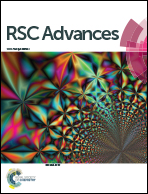Growth mechanisms and mechanical properties of 3D carbon nanotube–graphene junctions: molecular dynamic simulations†
Abstract
The growth process of carbon nanotube (CNT)–graphene 3D junctions on copper templates with nano-holes was simulated with classical molecular dynamic (MD) simulation. The CNT, graphene and their seamlessly C–C bonded junction can form simultaneously on the templates without catalysts. There are two mechanisms of junction formation: (i) CNT growth over the holes that are smaller than 3 nm, and (ii) CNT growth inside the holes that are larger than 3 nm. The tensile strengths of the as-grown C–C junctions, as well as the junctions embedded with metal nanoparticles (catalysts), were determined by a quantum mechanics MD simulation method. Metal nanoparticles as catalysts remaining in the junctions significantly reduce the fracture strength and fracture energy, making them brittle and weak. Among the junctions, the seamlessly C–C bonded junctions show the highest tensile strength and fracture energy due to their unique structure. This work provides a theoretical basis and route for synthesizing high-quality single-layer CNT–graphene nanostructures.


 Please wait while we load your content...
Please wait while we load your content...